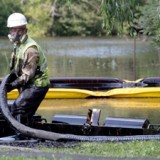The complicated relationship between ice ages and atmospheric carbon dioxide levels has just become a little clearer thanks to the work of Dr. Larry Edwards and a team of researchers from the University of Minnesota. Although such science may seem esoteric, it is vital in explaining the heating effect we are having on Earth’s climate by burning massive amounts of CO2-emitting fossil fuels. Dr. Edward’s work also helps to explain the cyclical arrival of ice ages and how our Industrial Age is impacting these cycles (New Scientist, May 22/10). With such insights, we can better anticipate the consequences of our behaviour and take corrective measures.
Suspicion began as early as 1864 that Earth’s changing tilt may have something to do with ice ages. More serious work was done in the early 20th century by Milutin Milankovitch, a Serbian engineer who spent decades examining variations in Earth’s orbital cycles and the tilt of its axis from 22 to 24 degrees and back again every 41,000 years. Milankovitch theorized that the angle and intensity of sunlight striking our planet could have an effect on the warming and cooling that seem to cause the rhythmical advance and retreat of ice ages – an ice age could be initiated by a cooler summer sun allowing a gradual accumulation of polar snow and ice. A more serious examination of Milankovitch’s work began in the late 20th century as global warming and climate became a puzzle of greater scientific interest.
But climate science is rarely tidy. The arrival and departure of ice ages didn’t always correlate to Milankovitch’s tilt model. Besides, polar ice only appeared on our planet about 30 million years ago. If his model were the sole explanation, then ice ages should have occurred regularly throughout Earth’s history.
The hidden variable was carbon dioxide. Scientists now know from studying marine sediments, ice cores, coral and stalagmites that atmospheric CO2 levels began to gradually fall about 30 million years ago, causing a cooling trend that, by about 2.5 million years ago, eventually brought the temperature level low enough for the axis cycle to have its effect. As expected, minor ice ages occurred every 41,000 years until about 1 million years ago. Then the ice ages began “missing a beat” and became major. Neither CO2 levels, tilt nor Earth’s other orbital irregularities could explain the magnitude of these more extreme ice ages. Some other dynamic was causing them. Complicating the explanation was the fact that CO2 levels were rising and falling simultaneously with the advance and retreat of the ice sheets, not ahead of them. If changing CO2 levels were coincidental, they were not causal. What was happening?
The new explanation is that ice ages are partly responsible for their own demise. As they get larger and heavier, they depress the planet’s crust, thus lowering their elevation and causing melt from higher temperatures. Additionally, the foundations of the ice sheets may sink below sea level, allowing warm ocean water to undermine and destabilize them. When Earth’s axis shifts enough to cause additional summer warming, then the ice age ends.
But what explains the increased levels of carbon dioxide that rise and fall simultaneously with the ice ages? The answer resides in the effect of the melting ice.
Melting ice releases huge amounts of fresh water, overlaying the northern oceans with a surface of reduced salinity and density. This shuts down “the Atlantic overturning circulation – the great ocean current that carries heat north, then sinks and flows back along the bottom of the ocean.” The south-and-north distribution of heat stops and the southern oceans become warmer. Since warmer water holds less dissolved gas, huge quantities of CO2 are released into the atmosphere causing additional warming, more melting and less oceanic heat distribution. This process continues until the ice is melted, an equilibrium re-establishes, and the system waits for the cycle to begin again.
The relevance for us today is that our industrial burning of fossil fuels is emitting enough carbon dioxide to alter this cycle. If conditions were normal, we would be entering one of the 41,000-year cooling cycles. But rapidly climbing CO2 levels – they have exploded in geological time from 280 to 390 parts per million in an incredibly brief 250 years – are quickly returning us to conditions that preceded the first polar ice of 30 million years ago. Our climate is “currently on course to become like that of the Miocene 10 to 15 million years ago, long before the ice age cycle began, when it was 6°C warmer and sea level was up to 40 metres higher” (Ibid.).
The solace in this news is that our fossil fuel emissions are preventing an oncoming ice age thousands of years hence. The disquieting news is that these same emissions are causing an almost instantaneous temperature rise and a destabilizing impact on the stable inter-glacial period that allowed us to develop our civilization. We will soon be confronting climate conditions that are entirely new to our human species. The rapidity of this new climate change permits no time for species and ecosystems to adapt. And, as adaptable as we like to think we are, it presses us to adjust our agriculture, relocate our settlements, modify our water use, alter our resource consumption, shift our energy sources, and prepare our huge and diverse global population for dramatic changes.
We have learned a huge amount about ice ages and climate change since serious study began less than a century ago. We still have much to learn about our effect on Earth’s climate, how we will mitigate the changes we are unleashing, and how we intend to adapt to these new circumstances.








